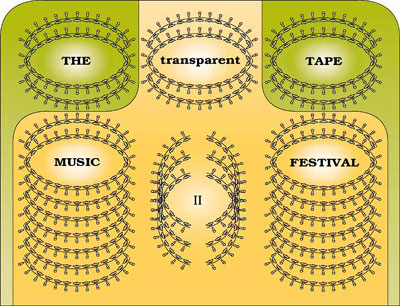Klang (1982) 9'00"
The title ("Klang" is the German for sound) reflects the onomatopoeic nature of the family of sounds providing the raw material for the piece - sharp, metallic attacks with interesting resonances rich in harmonics. The real starting point for Klang was the discovery of two earthenware casseroles, the sounds of which were recorded in the Electroacoustic Music Studio of the University of East Anglia during the summer of 1981. Material of two kinds was recorded - attack/resonance sounds made by tapping the lids on or in the bowls, and continuous rolling sounds made by running the lids around the insides of the bowls. Different pitches resulted from the various combinations of lids and bowls, and different qualities of resonance emerged according to the attack position. The microphones were placed very close to the bowls to maximise the movement within the stereophonic image. Other related material, accumulated over the previous three or four years, was also used. This included both "concrete" sounds, such as cow-bells, metal rods and aluminium bars, and electronically generated sounds, both analogue and digital. The final impetus to compose the piece came in June 1981 when the composer was invited by Janos Decsenyi of Magyar Radio to work in the Radio's Electronic Music Studio in Budapest. As studio time would be limited he was advised to take a certain amount of taped material with him; the two weeks prior to the visit were therefore spent in preliminary work in the Electroacoustic Music Studio of The University of Birmingham. Most of the opening two sections of the piece were composed before going to Hungary.
Although continuous, Klang falls into six short, fairly clearly defined sections:-
1. Introduction
2. Development 1 - duet
3. Development 2 - interruption of duet and increase in complexity towards the first climax
4. Development 3 - relatively static section
5. Development 4 - proliferation of material from Development 3 into glissando structures; build-up to the second
6. (main) climax, and slow release to:
7. Coda
The listener can trace the development of the material from raw statements of casserole sounds in the Introduction, through more complex, highly transformed events in the four Development sections, back to the opening sound-world in the Coda. The most obvious transformation technique is mixing, using only slightly transposed versions of simple sounds. Besides mixing and transposition with tape recorders and a harmoniser, the main modifications were achieved by filtering and, most important of all, montage. This last technique is the principal means of controlling the timing and rhythmic articulation of the material and its organisation into phrases (which may be a single line or a mix of many layers which are edited together into the desired sequence).
Klang was commissioned by MAFILM and composed in the Electronic Music Studio of Magyar Radio in 1982. It was awarded Second Prize in the Analogue Category of the Bourges International Electroacoustic Music Awards in 1983. It has been performed and broadcast in many parts of the world, including at the 1984 ISCM World Music Days in Toronto, Canada. It appeared on the UEA record label and has just been released on CD on the NMC label (London). In 1992 it was awarded a Euphonie d'or at Bourges as one of the twenty most significant works from two decades of the Bourges Awards.
Jonty Harrison (born 1952)
studied with Bernard Rands at the University of York, graduating with a DPhil in Composition in 1980. Between 1976 and 1980 he lived in London, working at the National Theatre (where he produced the tape components for many productions, including Tamburlaine the Great, Julius Caesar, Brand and Amadeus) and City University.
In 1980 he joined the Music Department of The University of Birmingham, where he is now Senior Lecturer, as well as Director of BEAST (Birmingham ElectroAcoustic Sound Theatre) and the Electroacoustic Music Studios; for ten years he was Artistic Director of the Department's annual Barber Festival of Contemporary Music.
He has been a Board member of Sonic Arts Network for many years (Chair 1993-96), his main responsibility being liaison with agencies in various parts of the UK in an attempt to establish a National Studio. He plays an active role in the musical life of Britain, serving on a number of committees, as well as making conducting appearances with the Birmingham Contemporary Music Group (most notably conducting Stockhausen's Momentein Birmingham, Huddersfield and London) and the University New Music Ensemble. He has been a member of the Music Advisory Panel of the Arts Council of Great Britain and of the Council of the Society for the Promotion of New Music.
As a composer he has received several Prizes and Mentions in the Bourges International Electroacoustic Music Awards (including, in 1992, a Euphonie d'Or for Klang, cited as one of the "significant works" of the Bourges competition's history), Distinction and Mention in the Prix Ars Electronica in Linz, Austria, First Prize in the Musica Nova competition, Prague, the Lloyds Bank National Composers' Award, the PRS Prize for Electroacoustic Composition, an Arts Council Composition Bursary and a Leverhulme Research Grant. Commissions have come from many leading performers and studios, including the Groupe de Recherches Musicales, Paris, the Groupe de Musique Expérimentale de Bourges, the International Computer Music Association, MAFILM/Magyar Rádió, Budapest, IRCAM/Ensemble InterContemporain, Paris, the BBC, the Birmingham Contemporary Music Group, the Fine Arts Brass Ensemble, the Nash Ensemble, Singcircle, John Harle, Beverly Davison, Harry Sparnaay and Jos Zwaanenburg.
His music is performed and broadcast worldwide, and several works are available on CD: Pair/Impair, ...et ainsi de suite..., Unsound Objects, Aria and Hot Air on Articles indéfinis, a Jonty Harrison "solo" CD on the empreintes DIGITALeslabel (Montreal); Klang and EQ on NMC (London). Upcoming releases include Sons transmutants/sans transmutant and Ottone on Merlin and Unsound Objects as part of the CDCM collection on Centaur.

